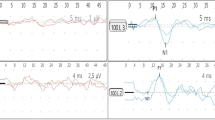Abstract
Vertigo is a medical condition where a person feels as if they or the objects around them are moving when they are not. Any disturbance in the functioning of vestibular organ may cause vertigo. This study aims to find the role of cervical Vestibular evoked myogenic potential in diagnosing BPPV. The study performed was a prospective study of 50 patients with the age distribution from 20 to 60 years of age, attending the OPD in ENT department of MY Hospital, Indore with complaints of Vertigo. c-VEMP test was performed. The results were evaluated to diagnose BPPV. Of all the patients with the complaints of vertigo maximum belonged to the 5th decade of life. Of all the patients, females were found to be affected more than males making the male female ratio to be 1:1.28. In our study Dix–Hallpike test was found to be positive in 38 (74%) patients. On performing cervical VEMP, 15 (30%) patients of 50 patients showed abnormal latencies and amplitudes suggesting abnormal saccular functioning on affected side. Of these 15 abnormal VEMPs, 13 patients were positive on performing Dix–Hallpike test i.e. were diagnosed to have BPPV. VEMP showed a positive correlation with Dix–Hallpike test in diagnosis of vertigo of postural origin and thus can be used as a diagnostic tool for BPPV as VEMP is found to have high specificity.






Similar content being viewed by others
References
Walker HK, Hall WD, Hurst JW (eds) (1990) Clinical methods: the history, physical, and laboratory examinations, 3rd edn. Butterworths, Boston
Biswas A (1995) Clinical audiovestibulo-metry for otologists and neurologists. Chapter 11, 5th edn. Bhalani Publishing House, New Delhi, pp 447–493
Yetiser S, Ince D, Gul M (2014) An analysis of vestibular evoked myogenic potentials in patients with benign paroxysmal positional vertigo. Ann Otol Rhinol Laryngol 123:686–695
Salviz M, Yuce T, Karatas A, Balikci HH, Ozkul MH (2015) Diagnostic value of frequency—associated vestibular-evoked myogenic potential responses in Meniere’s disease. Audiol Neurootol 20:229–236
Murofushi T, Iwasaki S, Ushio M (2006) Recovery of vestibular evoked myogenic potentials after a vertigo attack due to vestibular neuritis. Acta Otolaryngol 126:364–367
Mauricio CE, Alanis-Nunez AJ, Andres S, Teresa GG (2018) Dizziness and vertigo in emergency: a population-based analysis. J Otol Rhinol 7:1. https://doi.org/10.4172/2324-8785.1000
Patangay KK, Ansari R (2014) Benign paroxysmal positional vertigo: our experience. Indian J Otolaryngol Head Neck Surg 68(1):39–41
Nguyen-Huynh AT (2012) Evidence-based practice: management of vertigo. Otolaryngol Clin North Am 45(5):925–940. https://doi.org/10.1016/j.otc.2012.06.001
Caldas MA, Ganança CF, Ganança FF, Ganança MM, Caovilla HH (2009) Clinical features of benign paroxysmal positional vertigo. Braz J Otorhinolaryngol 75(4):502–506
Lopez-Escámez JA, Gámiz MJ, Fi-ana MG, Perez AF, Canet IS (2002) Position in bed is associated with left or right location in benign paroxysmal positional vertigo of the posterior semicircular canal. Am J Otolaryngol 23:263–266. https://doi.org/10.1053/ajot.2002.124199
Yang WS, Kim SH, Lee JD, Lee WS (2008) Clinical significance of vestibular evoked myogenic potentials in benign paroxysmal positional vertigo. Otol Neurotol. 29(8):1162–1166
Hong SM (2008) Vestibular evoked myogenic potentials in patients with benign paroxysmal positional vertigo involving each semicircular canal. Am J Otolaryngol 29(3):184–187
Kim EJ et al (2015) Persistent otolith dysfunction even after successful repositioning in benign paroxysmal positional vertigo. J Neurol Sci 358(1–2):287–293
Pascual PM, Merino PA (2019) Otolithic damage study in patients with benign paroxysmal positional vertigo with vestibular evoked myogenic potentials. Acta Otorrinolaringol Esp 70(3):131–135
Semmanaselvan K, Vignesh SS, Muthukumar R, Jaya V (2019) Vestibular evoked myogenic potentials after epleys manoeuvre among individuals with benign paroxysmal positional vertigo. Indian J Otolaryngol Head Neck Surg 71(2):195–200
Funding
This study was not funded by any source.
Author information
Authors and Affiliations
Corresponding author
Ethics declarations
Conflict of interest
The authors declare that they have no conflict of interest.
Ethical Approval
All procedures performed in studies involving human participants were in accordance with the ethical standards of the institutional and/or national research committee and with the 1964 Helsinki declaration and its later amendments or comparable ethical standards.
Human and Animal Rights
This article does not contain any studies with animals performed by any of the authors.
Informed Consent
Informed consent was obtained from all individual participants included in the study.
Additional information
Publisher's Note
Springer Nature remains neutral with regard to jurisdictional claims in published maps and institutional affiliations.
Rights and permissions
About this article
Cite this article
Godha, S., Upadhyay Mundra, A., Mundra, R.K. et al. VEMP: An Objective Test for Diagnosing the Cases of BPPV. Indian J Otolaryngol Head Neck Surg 72, 251–256 (2020). https://doi.org/10.1007/s12070-020-01802-3
Received:
Accepted:
Published:
Issue Date:
DOI: https://doi.org/10.1007/s12070-020-01802-3



